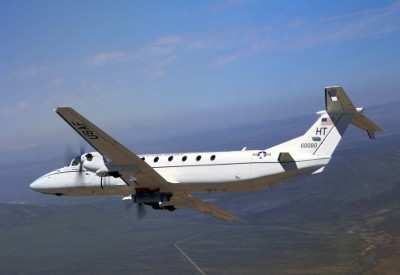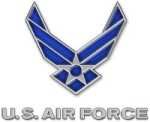C-12J Has Pylons, Bomb Racks Added To Its Fuselage
The 586th Flight Test Squadron, part of Air Force Materiel
Command's 46th Test Group, recently hit an aviation milestone when
members of the unit completed flight testing of an inert missile,
the LTGM-65 Laser Maverick, currently under development by Raytheon
Missile Systems. Air Force testers have flown many variants of the
air-to-ground missile throughout the years, but the significance of
this testing was the aircraft used to carry it: an Air Force
C-12J.

Modified C-12J USAF Photo
Normally a "people mover," this C-12, nicknamed "Ms. Mable," is
an Air Force version of a Beech 1900C airliner that has been highly
modified to support agile, low-cost testing of advanced avionics
and weapons. Perhaps the most unusual modification is the addition
of two pylons and bomb racks that enable the aircraft to carry test
items, like the Laser Maverick, on the belly of its fuselage.
"This is a really unique test capability ... because you usually
don't find missiles underneath a transport aircraft," said Capt.
Reid Larson, chief flight test engineer with the 586th FLTS. He
also noted that the aircraft does not launch the missiles; it only
carries them into the air for testing purposes. Larson said the
concept of placing bomb racks on the aircraft was born about three
years ago when the need was identified for testing external stores
at slower speeds and at significantly lower cost than testing on a
typical fighter aircraft. "There is a real need for an inexpensive
way to conduct risk-reduction flight testing," he explained.
"Testing early in the development helps work out the major bugs in
a new weapon or system before loading it on a fighter that costs
much more to operate."
"(This capability) provides a much-needed low-cost, long-loiter
capability for weapons and avionics development," added Lt. Col.
Monte Cannon, the 586th FLTS commander. According to Colonel
Cannon, the C-12 is cheaper to operate per flight hour largely
because it consumes significantly less fuel than an F-15 Eagle or
F-16 Fighting Falcon, for example. "There is obviously a tradeoff
here," he said. "We can't go nearly as fast as a fighter, but
that's fine in the early stages of testing."
He explained that once the test item has proven itself during
this early testing, it gets flown on the aircraft from which it
will be employed. "A team of experienced pilots and engineers
across the 46th Test Group initially began a study to assess the
feasibility of attaching bomb racks to the C-12J," said Captain
Larson. "The team determined that it was not only something that we
could do, but also should do. It made sense from a technical
perspective and from a cost-savings perspective." What followed was
a two-year design and modification effort, followed by a year-long
test program to verify that the addition of the bomb racks did not
affect the behavior of the airplane during flight.

The recently-completed Laser Maverick testing marks the first
time this new capability has been used. The program aimed to show
that this variant of the Maverick could successfully track a fast
moving target illuminated by a laser. "The need to strike mobile
targets was identified as an urgent need for current operations in
theater," said 2nd Lt. Rob Erickson, lead flight test engineer for
the program. "By any measure, this was an enormously successful
demonstration. It was truly a team effort with outstanding support
from the (people at) White Sands Missile Range as well as numerous
members (from) Holloman."
Operators from one of Holloman's remotely piloted aircraft
flying training units also assisted in the testing. "We were
especially excited to work with members of 6th Reconnaissance
Squadron who operated an MQ-1 Predator to laser designate the
simulated target as part of the testing," said Colonel Cannon.
But Captain Larson said the squadron doesn't have long to savor
this success. There are plans in the works to certify several other
technologies for flight on Ms. Mable. "We're looking to eventually
test targeting pods, such as LITENING and SNIPER, that would allow
us to zoom in on, track and even laser designate targets just like
many of our fighters can," he said.
Each of these technologies will provide a key capability to
support the squadron's test customers. "In the end, this is about
providing world class testing that helps cost-effectively verify
new combat capability," Colonel Cannon said. "Our aim is to help
get things right before the weapon or system gets to the
fight."
 Aero-News: Quote of the Day (10.23.25)
Aero-News: Quote of the Day (10.23.25) ANN's Daily Aero-Linx (10.23.25)
ANN's Daily Aero-Linx (10.23.25) ANN FAQ: Turn On Post Notifications
ANN FAQ: Turn On Post Notifications Classic Aero-TV: Kitfox Upgrades Back-Country Undercarriage
Classic Aero-TV: Kitfox Upgrades Back-Country Undercarriage Airborne-NextGen 10.21.25: NZ Goes Electric, World Cup UAVs, eAviation Shuttered
Airborne-NextGen 10.21.25: NZ Goes Electric, World Cup UAVs, eAviation Shuttered




